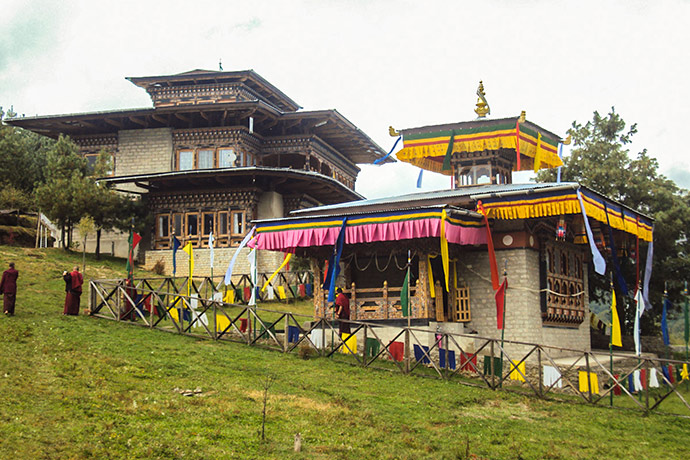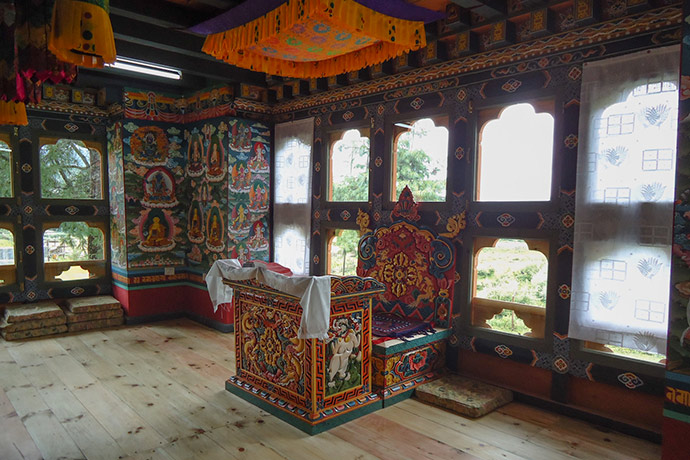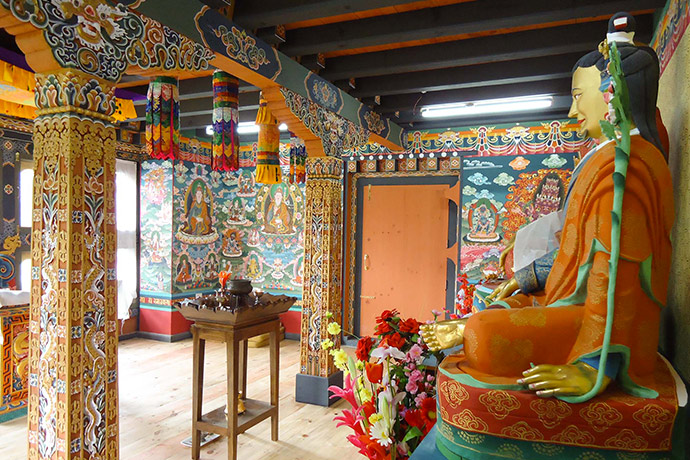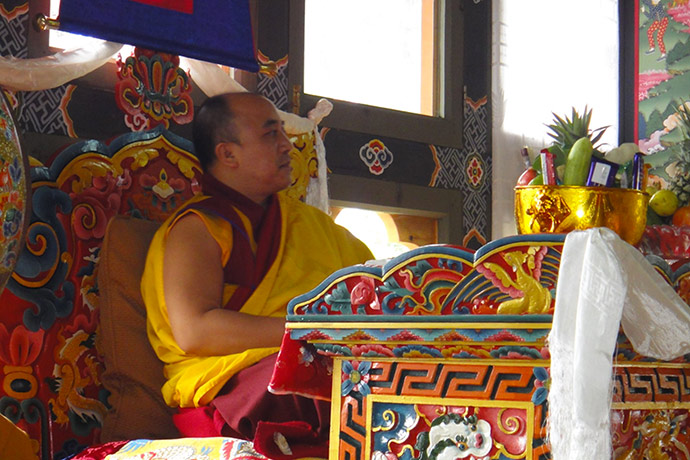
Meditation
Meditation Room
Relax your mind, body and soul and reconnect with your spirit. Spend a few quiet moments inside the serene room at Padma'i Denzin Lhakhang. Padma'i Denzin Lhakhang may be the only Nyingmapa temple in the world dedicated to great Nyingmapa masters. Inside, a clay statues of Longchen Rabjam in the centre is flanked by Ugyen Pema Lingpa and Rigdzin Jigme Lingpa. Each statue is filled with the holiest of Buddhist relics.
Three corners of the walls are decorated with colorful murals of saints, masters, and guardian deities painted by young, traditional Bhutanese painters. The lhakhang's soothing, meditative ambiance inspires peace and prayer.
The temple was consecrated and named by Kyabje Dungse Thinle Norbu Rimpoche during construction phase in 2009, and formally consecrated in 2010 by H.E the 7th Namkhai Nyingpo Rinpochhe, one of the greatest Nyingmapa masters of this age. The temple has been recognized and blessed by His Holiness as the "Holder of the Lotus Born Buddha's Place," a literal English translation of its name. It was built in memory of the late proprietor of the resort who was a devout Buddhist.
We invite you to visit our lhakhang and enjoy a moment of quiet meditation and tranquility.
About the Nyingmapa Masters
Gyalwa Nyipa Longchen Rabjampa (1308-1363)
Longchenpa Rabampa is often referred to by the honorary title Second Buddha, a term usually preserved for Padmasambhava and indicative of the high regard in which he and his teachings are held.
Longchen Rabjam was an incarnation of Princess Pema Sal, the daughter of King Trisong Deutsen, to whom Guru Rinpoche had entrusted his own lineage of Dzogchen known as Khandro Nyingthig.
The figure of Longchen Rabjam stands out as one of the greatest Dzogchen masters in the Nyingma tradition, and amongst the most brilliant and original writers in Tibetan Buddhist literature. He is single-handedly regarded as the most important writer on Dzogchen teachings. He was the author of over 200 works, of which only about twenty-five survive, and amongst which the Seven Treasuries (Dzö Dun) and Three Trilogies are most well-known. It was he who brought together into a cohesive system the teachings of Vima Nyingtik and Khandro Nyingtik, on which he wrote the 'Three Yangtik' or Inner Essences. During his stay in Bhutan, Longchenpa founded eight monasteries called ling gyad, including Tharpaling near Bumthang.
Ugyen Pema Lingpa (1450-1521)
Pema Lingpa was a famous saint and siddha of the Nyingma school of Mahayana Buddhism. He was a preeminent terton discoverer of ancient texts, and is considered to be foremost of the Five Terton Kings. In the history of the Nyingma school in Bhutan, Pema Lingpa is second only in importance to Padmasambhava himself.
According to the prophesy of Padmasambhava, Padma Lingpa's legacy was to reveal I08 Dharma treasures, but due to inauspicious circumstances, he successfully extracted only 32 terms. These fully intact teachings have until the present day formed the basis for most of the Buddhist practice in Bhutan . Both the family lineage and lineage of incarnations of Padma Lingpa have continued to produce great masters and leaders. The present royal family and the King of Bhutan descend from Padma Lingpa.
The transmission of Pema Lingpa's profound doctrines was gradually passed down and propagated by his mind, speech and body reincarnation. Thus, the entire stream of its empowerments, transmissions, and guidance from a number of great masters has continued, unbroken, up to the present.
Rigdzin Jigme Lingpa (1729-1798)
Over his lifetime Jigme Lingpa produced nine volumes of texts and treatises. These volumes contain the basic root treatises of the Heart Point of the Great Expanse, the Longchen Nying-t'ig. The Yon-ten Rinpoche'i Dzod and its two-volume commentary form his most famous work. He also composed a ritual text called the Vajrakilaya according to Tantric Tradition (phur-ba rgyud-lugs), a work on exorcism and magic.
Jigme Lingpa consistently applied whatever wealth came his way to promote the Buddha Dharma, especially in the sense of restoring or reviving the great wisdom of the past. For example, he recognized and restored key architectural sites and meditation caves from Tibet 's first Buddhist period. The preservation of the wisdom of this earlier period became a key preoccupation of his. He also presented a wheel of fine gold to the great temple of Samye Monastery and paid to have a silver statue of the Future-Buddha, Maitreya, erected in one of the Samye chapels.
He became the Guru of aristocratic Lhasa society and attracted patronage from the royal family of Derge in far eastern Tibet . Through these connections he was able to revive the Nyingma school and its practices at a time when it was languishing, as the result of considerable persecution from other schools and the destruction of many of its major centres.
When the Gurkha army of the south marched into Tibet and came up against Samye, with the design of striking at Lhasa , the heart of the country of Tibet , Jigme Lingpa raised up a spiritual barrier to avert the conquest. This resulted in the army not being able to go any further. Thus he succeeded by miraculous means in putting an end to the war and saved Tibet from foreign conquest. Consequently the Tibetan government granted him many honours and veneration.



